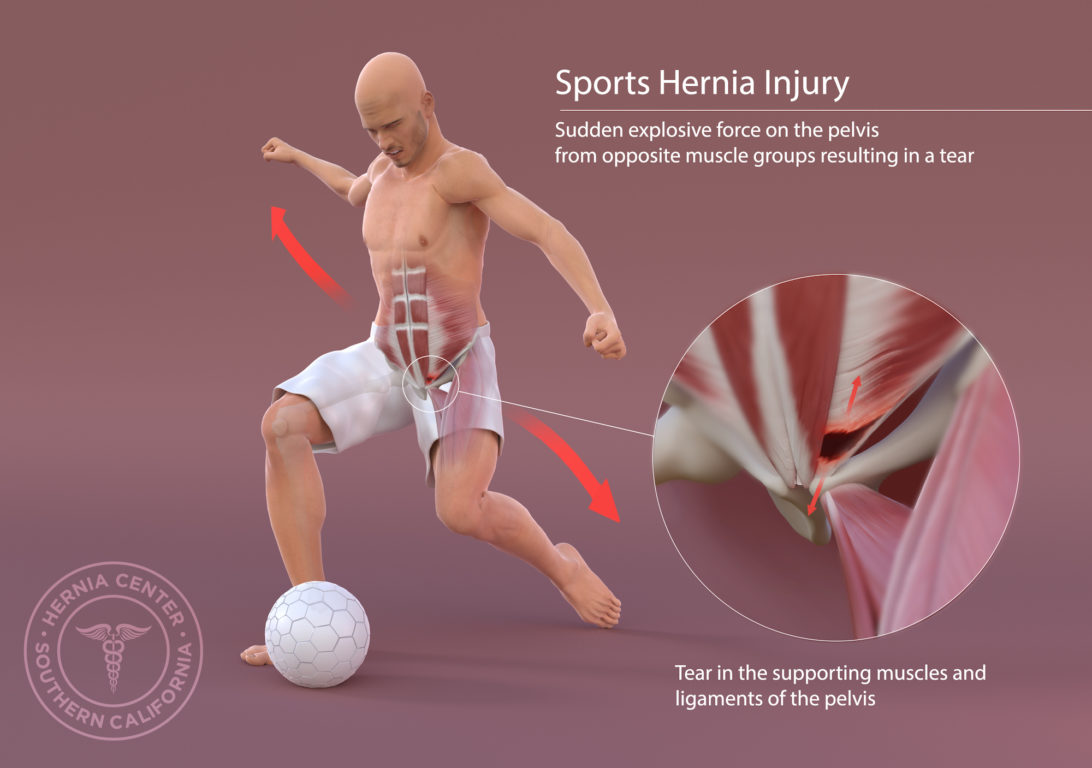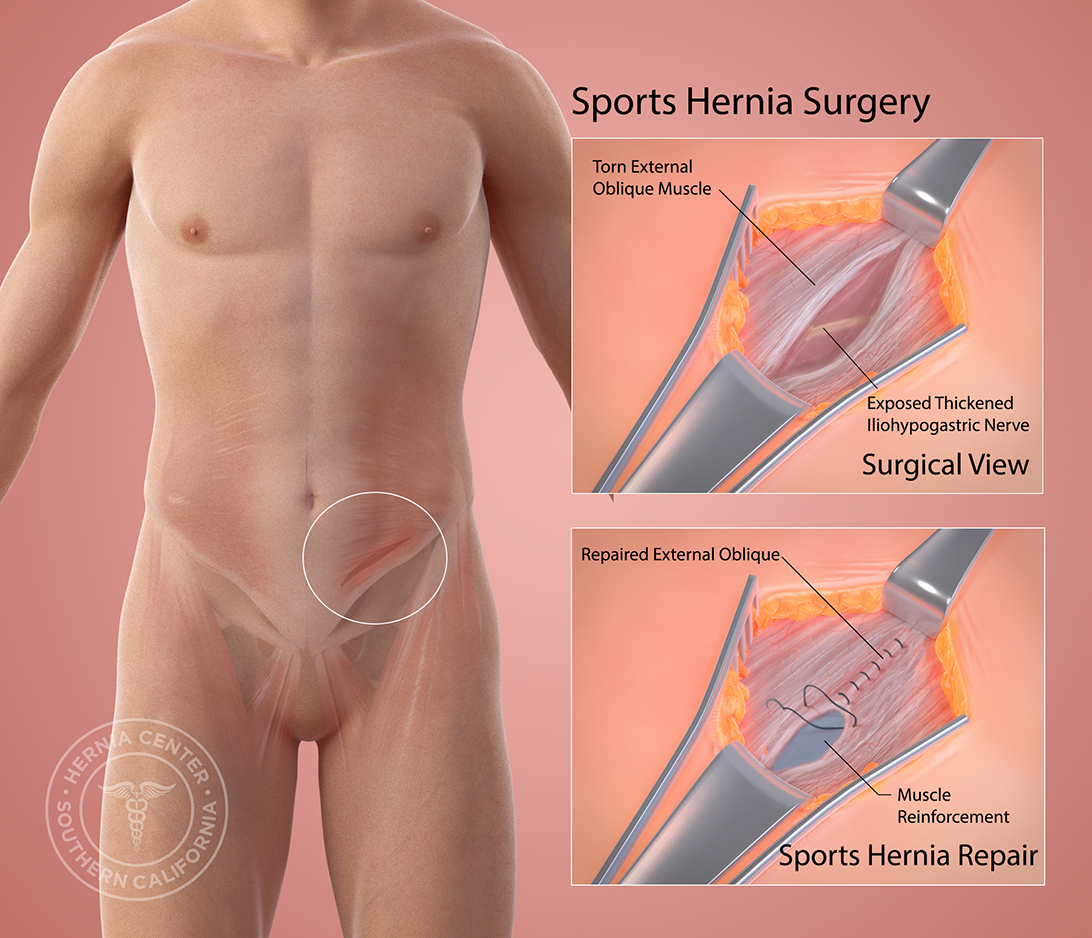COVID-19 ProtocolsLearn More
Covid-19 Safe Environment - CDC Guidelines In Place - Learn MoreBook Release Announcement - The Hernia Solution, 2nd Edition - Click here for more information
Need help? Call us 626.584.6116
A sports hernia, medically known as athletic pubalgia, occurs when the lower abdomen muscles are strained to a point where they tear or rip, causing pain in the lower abdomen and groin area. In this type of injury, the pain usually begins slowly, then increases in intensity with time. Sports hernias occur in both professional and recreational athletes. While it is mostly men who sustain sports hernias, women can also incur them.
Even athletes with strong abdominal muscles are subject to sports hernias. This is because they usually do not happen all at once. Rather, they develop gradually through shearing forces created by simultaneous contraction of the abdominal wall and thigh muscles pulling in different directions. This occurs more commonly during side-to-side movements, resulting in small tears or rips in the muscle that exacerbate until they become a more serious problem.
A sports hernia is often confused with and misdiagnosed as a groin strain. A strain will usually heal on its own in two to six weeks, whereas a sports hernia may require surgery. A sports hernia is differentiated from the classic inguinal hernia in that there is no observable hernia bulge.
If you are a professional or recreational athlete who believes (or already knows) you have a sports hernia, who better to advise you on treatment than fifteen-time Ironman finisher and hernia specialist, Dr. David Albin, who has performed 20,000-plus hernia surgeries and has over 30 years experience? Dr. David Albin recently lent his expertise to Triathlete Magazine on the topic of sports hernias to help their readers understand what a hernia is along with symptoms, causes, and prevention. Click here to read the article.
At the Hernia Center of Southern California, Dr. David Albin and his son—Dr. Michael Albin—have treated thousands of high-profile professional athletes, college athletes, and recreational athletes suffering from sports hernias. Our doctors are highly recognized experts in sports hernia repair with the ability to employ all types of advanced open and laparoscopic hernia surgery techniques. This includes the revolutionary and internationally renowned Albin Tension Free Mesh Technique, which is a modernized version of the conventional Tension Free Mesh Technique that was developed by Dr. David Albin himself.
For more information about sports hernias and treatment options, please continue reading the sections provided below, or simply reach out to us online or by telephone today to schedule a consultation with one of our board-certified hernia physicians.

The following signs and symptoms commonly occur with sports hernia patients:
Pain from a sports hernia generally begins slowly with an ache in the lower abdomen and/or groin region. The pain is usually on one side of the abdomen. The pain worsens with sudden movements such as kicking, sprinting, twisting, and high levels of activity.
Diagnosis of a sports hernia is determined by the patient’s health history and a physical examination. Tests may be performed to rule out other causes for the groin pain. An MRI can be used to detect a sports hernia, but it’s not always positive. More often, simple methods will tell, such as having the patient perform an activity like sit-ups or a straight leg lift. If the patient’s pain intensifies during these movements, it’s likely a sports hernia is the culprit.

Rest is the number one treatment for a sports hernia. It is usually partnered with applying an ice pack to the injured area three to four times a day for 20 to 30 minute periods, as well as taking anti-inflammatory medicines such as Motrin® or Aleve®. It can take anywhere from a few weeks to a few months for the symptoms to go away. However, the longer you continue participating in the causal activity, the longer it is going to take you to heal.
If the aforementioned treatments do not alleviate the symptoms of a sports hernia, surgery may be needed to repair the weakened abdominal wall. The operation of choice is an inguinal hernia repair. Our hernia surgeons believe that each athlete needs to be treated individually. For example, the sports hernia surgery for a professional linebacker or a weightlifter will differ from the type of hernia surgery for a sprinter or cyclist. Our sports hernia operations take into account the specific needs for each athlete, and are tailored accordingly.
There are three nerves in the inguinal region. With open surgery, the groin nerves are easily seen, evaluated, and treated. They are also examined for signs of inflammation or entrapment. Involved nerves are divided. This leaves a small area of numbness but, most importantly, it eliminates the pain.
There are three nerves in the inguinal region. With open surgery, the groin nerves are easily seen, evaluated, and treated. They are also examined for signs of inflammation or entrapment. Involved nerves are divided. This leaves a small area of numbness but, most importantly, it eliminates the pain.
Adductor longus tendon injuries are typically referred to an orthopedic surgeon. Some patients will obtain relief with an injection of steroids. On occasion, the tendon may need to be surgically repaired.
Every one of our patients receives an individualized rehabilitation program that is catered to their specific needs. Studies have shown that between 65% and 90% of athletes who undergo surgery are able to return to their regular athletic activity within about six weeks.
DISCLAIMER: The following schedules constitute a general return-to-activities for patients who’ve had the Albin Tension Free Mesh technique. Your regimen may be slightly different. After surgery, one of our doctors personally consults with each patient and individually initiates a rehab program depending on the patient’s healing and skill level.

One day after sports hernia surgery, we recommend walking for one hour per day. After two to three days, this is increased to two hours per day. Once patients are walking without any discomfort, then running is initiated.
Running activities are performed in five minute intervals. Patients can run for 20 to 40 minutes, or four to eight intervals of five minutes each, depending on their comfort or skill level.
A typical return-to-activity regimen will be as follows:







FOUR WEEKS after hernia surgery: You can typically return to most recreational and athletic activities (except weightlifting), including contact sports. By this time in the recovery process, you’ll likely be able to perform all original activity the same as you did before surgery. If you are still experiencing some discomfort, this is normal. However, if you experience sharp pain at this point in the recovery process, please contact your doctor as soon as possible.
Drs. David and Michael Albin strongly recommend that all athletes, no matter what the sport, regularly practice exercises which increase flexibility and strengthen pelvic muscles so as to avoid sports hernias altogether. And never jump right into your game or sport; always do a warm-up first.
The cost of sports hernia surgery with insurance varies based on the specifics of one’s specific healthcare plan, as well as variabilities in charges at the particular location that care is received. Since our doctors pride themselves on providing the highest-quality care at the best prices, we also offer patients in-network benefits at Huntington Memorial Hospital, California Hospital, and Beverly Hospital.
Our friendly staff will determine if we accept your particular policy. Once authorization is obtained, you will be informed of any copays or deductible limits that must first be reached. We can assist you with a breakdown of out-of-pocket expenses at the various locations.
The average cost of sports hernia surgery without insurance at the Hernia Center of Southern California is $4500. This price includes:
To help with the cost of your sports hernia surgery, we will be happy to discuss financing or other payment arrangements.